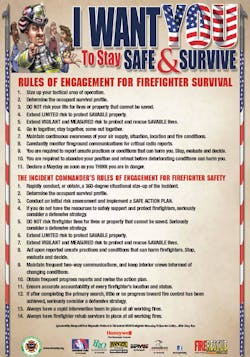Rules of Engagement Project; Increasing Firefighter Survival
Developed by the Safety, Health and Survival Section International Association of Fire Chiefs
The International Association of Fire Chiefs (IAFC) is committed to reducing firefighter fatalities and injuries. As part of that effort the nearly 1,000 member Safety, Health and Survival Section of the IAFC has developed the recently approved “Rules of Engagement of Structural Firefighting” to provide guidance to individual firefighters, and incident commanders, regarding risk and safety issues when operating on the fireground. The intent is to provide a set of “model procedures” for Rules of Engagement for Structural Firefighting to be made available by the IAFC to fire departments as a guide for their own standard operating procedure development.
In August, 2008, following a year of discussion, the Section moved to develop a set of “Rules of Engagement for Structure Firefighting”. A project team was created consisting of Section members and representatives of other several other interested fire service organizations. These included the Fire Department Safety Officer Association (FDSOA), the National Fallen Firefighter Foundation (NFFF), and the National Volunteer Fire Council (NVFC), the National Institute of Occupational Safety and Health (NIOSH) and other organizations. All draft material has also been shared with representatives of the International Association of Fire Fighters (IAFF) who developed a joint IAFF/IAFC “Fire Ground Survival Project”. Three Section members also participated in the IAFF project. The direction provided the project team by the Section leadership was to develop rules of engagement with the following conceptual points;
- Rules should be a short, specific set of bullets
- Rules should be easily taught and remembered
- Rules should define critical risk issues
- Rules should define “go” or “no-go” situations
- A companion lesson plan/explanation section should be provided
Early in development the Rules of Engagement, it was recognized that two separate rules were needed one set for the firefighter, and another set for the incident commander. Thus, the two sets of Rules of Engagement described in the attached document. The ROE were also inserted in the August issue of FireRescue magazine. Each set has several commonly shared bullets and objectives, but the explanations are described somewhat differently based on the level of responsibility (firefighter vs. incident commander).
The ROE document reflects nearly two years of public comment and feedback from several presentations at fire service conferences, including the National Fallen Fire Fighters Safety Summit held at the National Fire Academy this past March. The “Rules” were formally adopted by the IAFC Health, Safety and Survival Section at the Fire Rescue International Conference held last week in Chicago.
The development of the rules integrated several nationally recognized programs and principles. They included risk assessment principles from NFPA Standards 1500 and 1561. Also included where concepts and principles from Crew Resource Management (available from iafc.org) and data and lessons from the National Near-Miss Reporting System (firefighternearmiss.com). The development process also included review of lessons learned from numerous firefighter fatality investigations conducted by the National Institute of Occupational Safety and Health (NIOSH) Fire Fighter Fatality Investigation and Prevention Program.
It’s incumbent that the fire chief and the Departments management team insure the safety of all firefighters working at structural fires. All command organization officers are responsible for their own safety and the safety of all personnel working with them. All officers and members are responsible are responsible for continually identifying and reporting unsafe conditions or practices. The Rules of Engagement allows both the firefighter and the incident commander to apply and process these principles.
One principle applied in the Rules of Engagement is firefighters and the company officers are the members at most risk for injury or death. The Rules integrate the firefighter into the risk assessment decision making process. These members should be the ultimate decision maker as to whether it’s safe to proceed with assigned objectives. The “Rules” allow a process for that decision to be made while still maintain command unity and discipline. It is well known that firefighting is hazardous with varying levels of risk to the firefighter. However, firefighting is not a military campaign where lives are lost to establish a beach head. No firefighter’s life is a building that eventually will be rebuilt. Keep all members safe so “Everyone Goes Home”!
Rules of Engagement for Firefighter Survival
- Size-Up Your Tactical Area of Operation.
- Determine the Occupant Survival Profile.
- DO NOT Risk Your Life for Lives or Property That Can Not Be Saved.
- Extend LIMITED Risk to Protect SAVABLE Property.
- Extend Vigilant and Measured Risk to Protect and Rescue SAVABLE Lives.
- Go in Together, Stay Together, Come Out Together
- Maintain Continuous Awareness of Your Air Supply, Situation, Location and Fire Conditions.
- Constantly Monitor Fireground Communications for Critical Radio Reports.
- You Are Required to Report Unsafe Practices or Conditions That Can Harm You. Stop, Evaluate and Decide.
- You Are Required to Abandon Your Position and Retreat Before Deteriorating Conditions Can Harm You.
- Declare a May Day As Soon As You THINK You Are in Danger.
The Incident Commanders Rules of Engagement for Firefighter Safety
- Rapidly Conduct, or Obtain, a 360 Degree Size-Up of the Incident.
- Determine the Occupant Survival Profile.
- Conduct an Initial Risk Assessment and Implement a SAFE ACTION PLAN.
- If You Do Not Have The Resources to Safely Support and Protect Firefighters – Seriously Consider a Defensive Strategy.
- DO NOT Risk Firefighter Lives for Lives or Property That Can Not Be Saved – Seriously Consider a Defensive Strategy.
- Extend LIMITED Risk to Protect SAVABLE Property.
- Extend Vigilant and Measured Risk to Protect and Rescue SAVABLE Lives.
- Act Upon Reported Unsafe Practices and Conditions That Can Harm Firefighters. Stop, Evaluate and Decide.
- Maintain Frequent Two-Way Communications and Keep Interior Crews Informed of Changing Conditions.
- Obtain Frequent Progress Reports and Revise the Action Plan.
- Ensure Accurate Accountability of All Firefighter Location and Status.
- If, After Completing the Primary Search, Little or No Progress Towards Fire Control Has Been Achieved - Seriously Consider a Defensive Strategy.
- Always Have a Rapid Intervention Team in Place at All Working Fires
- Always Have Firefighter Rehab Services in Place at All Working Fires

Christopher J. Naum
CHRISTOPHER J. NAUM, SFPE a Firehouse® contributing editor, is a 40-year fire service veteran and a national instructor, author, lecturer and fire officer. He is an authority on building construction issues affecting the fire and emergency services and a former fire command officer, architect and fire protection engineer. Naum is a technical consultant and reviewer to the NIOSH firefighter fatality investigation and prevention program, an NFFF Firefighter Safety Advocate and formally served on the Board of Directors of the ISFSI and the IAFC Safety, Health & Survival section and faculty at the National Fire Academy. He was the 1987 ISFSI George D. Post National Fire Instructor Award recipient. Naum is the executive producer of Buildingsonfire.com and FiregroundLeadership.com, sites dedicated to building construction, adaptive fire command and firefighter safety.






